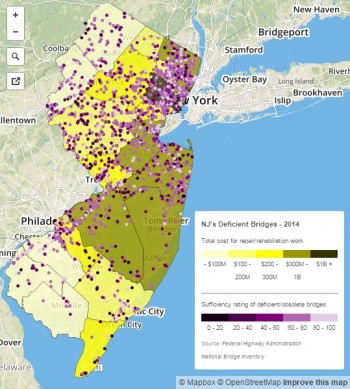
Three emergency bridge closures in the past month have renewed the focus on New Jersey’s transportation debt and misdirected transportation spending priorities.
Each year, Tri-State Transportation Campaign reviews and analyzes the New Jersey Department of Transportation’s Capital Program. The most alarming trend: funding for road expansion projects has increased year after year, while funding for keeping roads and bridges in a state-of-good-repair has not. These fix-it-first projects comprised just 32 percent of the FY2015 Capital Program, a greater percentage than in the previous two years, but still a steep fall from 44 percent in 2012.
In 2008, Tri-State released a report which predicted there would be an upswing in spending on road expansion:
“Spending on capacity expansion projects is projected to increase in coming years, threatening to undermine the state’s “fix-it-first” goals. While FY2009 funding for expansion projects remains a sliver of the total capital program at just 1.5 percent, by 2011 the share of total funding slated for widening and new roads is projected to grow to nearly 8 percent.”
And that upswing didn’t stop in 2011. The share of funding for expansion continued to grow in 2012 with 13 percent of capital program dollars and peaked in 2013 at 14 percent. It dipped in 2014 to 10 percent. Although the current capital program is only spending 3 percent on expansion projects, that doesn’t mean there’s been a dramatic shift back to a fix-it-first approach; two of 2014’s largest expansion projects—the Route 72 Manahawkin Bay Bridge, which received $36 million in the 2014 capital program, and Route 295/42 Direct Connect, which received almost $79 million in the 2014 program—are not included in the 2015 document, but will be included in future capital programs.
By putting off expensive expansion projects in this fashion, NJDOT can free up money for improving existing infrastructure. Adopting and adhering to a fix-it-first policy which prioritizes maintenance and preservation can reduce the Garden State’s backlog of structurally-deficient roads and bridges. And, a focus on existing roads and bridges means NJDOT won’t be adding to the number of roads and bridges to maintain.
If New Jersey doesn’t shape up the way it spends its transportation dollars, any increase in funding for the state’s Transportation Trust Fund could be for naught.

This is so important for the future wellbeing of our state. We simply can’t keep funding outward sprawl like we have over the past 60 years. New Jersey needs to reconsolidate its resources into the smaller, older, efficient towns built before World War II. These towns are much more resilient, both economically and socially, than the far flung, sprawling suburbs that got the bulk of state and federal subsidies since the end of the war.
[…] Will New Jersey Continue Misdirecting What Little Transportation Funding It Has? […]